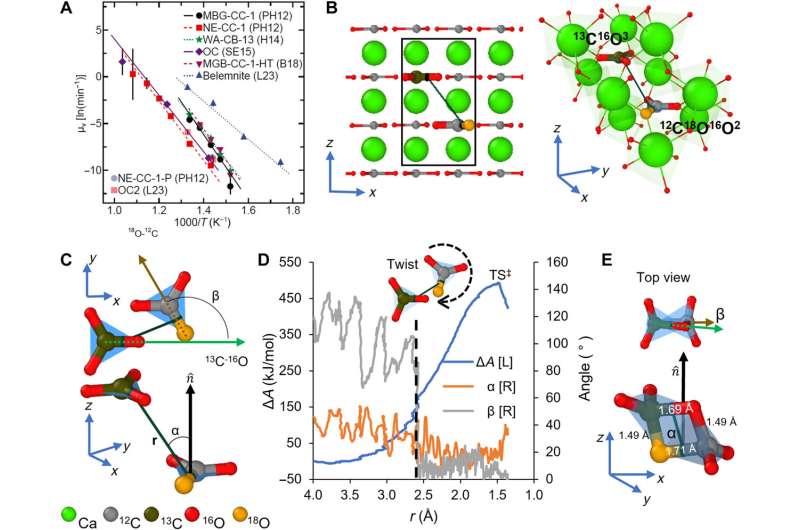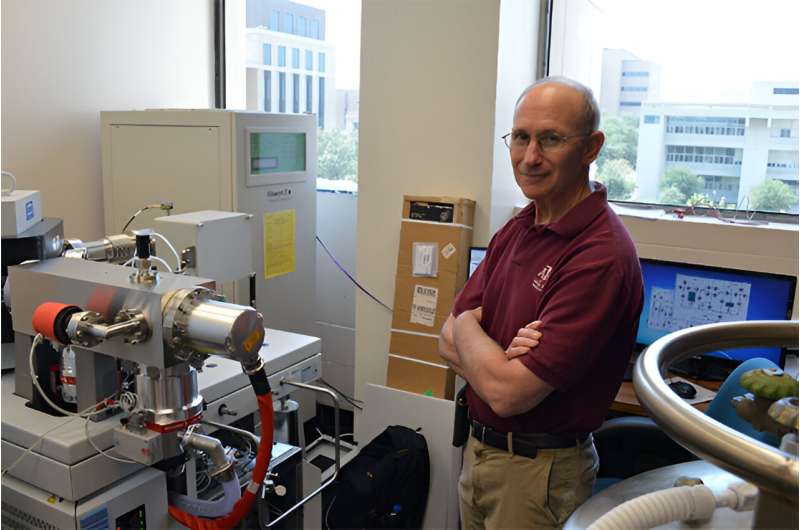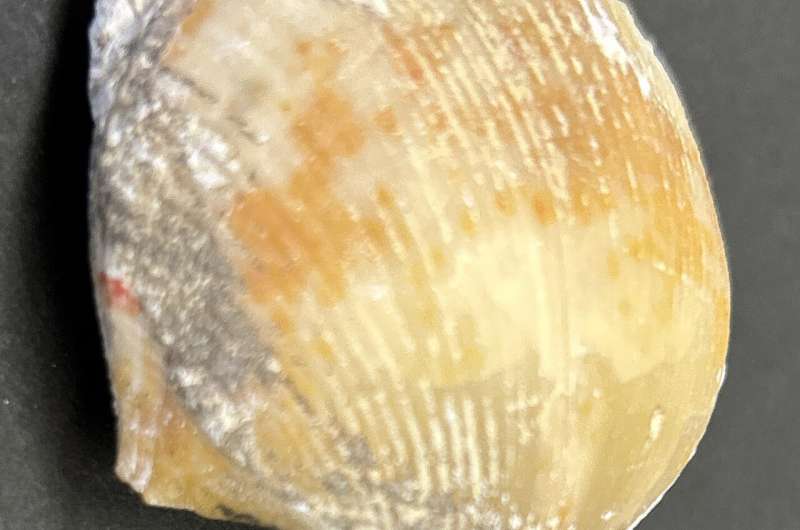This article has been reviewed according to Science X's editorial process and policies. Editors have highlighted the following attributes while ensuring the content's credibility:
fact-checked
peer-reviewed publication
trusted source
proofread
Taking the quest to more accurately measure ancient ocean temperatures to the atomic level

Carbon dioxide levels in Earth's atmosphere—and, consequently, ocean temperatures—are rising. How high and how fast ocean temperatures can rise can be learned from temperature measurements of ancient oceans. At the same time, energy exploration also relies on knowing the thermal history of oil and gas source rocks, which is often difficult to determine.
One of the most promising techniques for measuring ancient ocean temperatures and basin thermal histories relies on the co-enrichment of rare heavy oxygen and heavy carbon in the calcium carbonate compound found at the bottom of the ocean. This enrichment, termed clumped isotopes, is commonly measured using fossil shells and limestones to determine the temperatures at the time when sediments became deposited on the sea floor.
However, there's a catch: Clumped isotope temperatures can be reset by the very process of sediments being buried, causing those sediment temperatures to rise as they create the same conditions responsible for converting organic matter in sedimentary rocks to oil.
Such complex problems require interdisciplinary approaches—a collaborative mindset that thrives in the Texas A&M University College of Arts and Sciences, where a team of geologists and chemists has taken the quest to the atomic level to more accurately measure ancient ocean temperatures.
The team, led by Dr. Ethan Grossman in the Department of Geology and Geophysics and Dr. Sarbajit Banerjee in the Department of Chemistry, recently used a combination of supercomputing and density functional theory to model the process responsible for setting and resetting clumped isotope compositions, a phenomenon known as reordering.
The work is published in Science Advances.
"We were able to vividly simulate the motion of atoms and to capture the entire process underpinning rearrangement of carbon-oxygen bonds," said Grossman, holder of the Michel T. Halbouty Chair and co-director of the Stable Isotope Geosciences Facility at Texas A&M. "This modeling technique, commonly applied to simulate the behavior of atoms in many scenarios, including lithium-ion batteries and brain-like computing, is for the first time being used to examine the rare movement of atoms in fossil shells and limestone rock."

In comparing their results to previously published experimental results, Grossman says the team was also able to provide the missing link between experimentation and theory in identifying the catalytic culprit responsible for speeding up temperature resets in those clumped isotopes: water.
"We theoretically demonstrated for the first time that water in the crystal structure will hasten the resetting of clumped isotope temperatures, which thus warrants caution for how the approach is used to reconstruct ancient temperature records," Grossman added. "This supports experimental data that previously lacked a theoretical underpinning and will lead to more accurate reconstructions of past climates, which in turn provides understanding of future climate scenarios."
In addition to identifying the role of water as an accelerant in reordering, Grossman says the team's studies help explain other enigmatic results—notably, the modification of fossil-derived ocean temperatures to impossibly high values hovering around 150 degrees Celsius, or roughly 300 degrees Fahrenheit. They were able to determine such outliers using specimens from approximately 320-million-year-old marine sedimentary rock deeply buried in the past and now exposed in New Mexico and the Ural Mountains in Russia.
"Clearly, these organisms did not live in water hotter than boiling temperatures," he explained. "This finding pointed to the need to understand the burial history of fossils and the rates of clumped isotope reordering."

The team's results represent a pivotal first step in developing a unified theory for the clumped-isotope reordering kinetics in carbonate minerals that Grossman says will pave the way for more accurate determinations of ancient ocean temperatures and the thermal history of petroleum basins.
By illustrating how activation energy barriers and reordering rates are modified by crystal defects, ion substitution and incorporated water, they hope to contribute to more accurate reconstructions of past climates and a clearer understanding of future climate scenarios while also providing a mechanism for reconstructing the thermal history of sedimentary basins essential for oil and gas exploration.
"This study will allow for more accurate reconstructions of past climates by better understanding the depths of sediment burial beyond which clumped isotope temperatures from fossil shells are unreliable," Grossman said. "Furthermore, it demonstrates the value of collaboration between departments and fields that have not traditionally worked together to unveil fundamentally new knowledge."
"We have many unanswered questions," Grossman said. "For starters, how does this reordering rate vary with the amount of water in the crystal structure? How does it vary in different minerals? Can we develop protocols for identifying the fossil and mineral material most resistant to reordering? Can we define a calibration scale to correct for errors in each mineral? And lastly, can we use this information to develop a new and innovative approach to reconstruct basin thermal histories and refine oil and gas exploration? In sum, we are eager for our next steps."
More information: Saul Perez-Beltran et al, Density functional theory and ab initio molecular dynamics reveal atomistic mechanisms for carbonate clumped isotope reordering, Science Advances (2023). DOI: 10.1126/sciadv.adf1701
Journal information: Science Advances
Provided by Texas A&M University




















